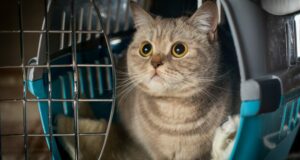Black cats have served as negative icons of superstition and sorcery for centuries. In many cultures the stigma that follows these animals is so deeply engrained that even today they may be shunned, abused and hated by some for what they supposedly represent. Black Cats face more discrimination and danger than the average tabby, particularly during the month of October as Halloween approaches. Contemporary rescue organizations and animal lovers may even take protective measures in October to protect the interests and well-being of these “unlucky” pets.
A Dark History
Domestic cats, as a species, have a long presence in folklore and superstition in cultures around the globe. Black coloration carries other connotations, so black cats such as pure bred Bombays, are hit with a “double whammy” in regards to how they may be percieved or treated. Perhaps the most prevalent negative association of cats is that to witches, devilry and black magic in the western world. These beliefs began largely in the middle ages when disease and death were rampant and people were looking for reasons for their dire circumstances. Actively hunting and exploring by the dark of night, shadowy feline figures unknowingly gained a reputation as being tools of evil practices, supernatural omens of misfortune and death. Some even believed cats could change shape and assume human form to carry out mischief or evil deeds.
With the unwarranted reputation earned by these creatures came fear and malice, and these innocent animals became targets for abuse, torture and in some cases execution. Some believed that cats were agents of the Devil, or in league with witches blamed for spreading plague and misfortune. For this they were often killed in numbers, which led to the proliferation of rats and therefore more widespread outbreak. Cats captured with or in the vicinity of accused witches were likely burned with their human companions. Even those cats that had proven thier worth as predators protecting wool and grain stores from pests often met a grim fate when thier services were no longer needed. They were often tossed from belfrys or rooftops as a symbolic cleansing of evil spirits.
Not All Bad

Black Cats in the Modern World
Superstition and the old ways of thinking haven’t all been left in the past. You may have heard the statistics that black pets are more likely to be left behind at shelters, passed over by prospective adoptees for one reason or another. Could all of the negative propoganda of the past still be influencing the animals we see today? Some of the same beliefs that held strong centuries ago still have a grasp in modern culture. The black cats I’ve known personally haven’t shown any distinct influence on my luck one way or another, but they have all been treasured for the affection and distinctive personality they brought to my family!
Happy Halloween
October may be considered the month of the black cat. The same dark history that lent these animals years of bad JuJu has given them a station as Halloween icons, their paper and plastic likenesses adorning windows and lawns along with witches, ghouls, and other past objects of fear and reprehension. Each year there are also tales of black cats being adopted around Halloween as temporary decor or for other unscrupulous and idiotic purposes. Black cats are much more than novelties and deserve loving homes like any other. Stories of torture and ritual sacrifices abound though may are unsubstantiated. Many shelters prefer to halt adoption of black cats near the holiday to prevent post-Halloween returns or other sad outcomes.
 If you’re lucky enough to already share your home with one of these ebony felines, chances are you already know how “lucky” you really are to have them in your life. The sleek raven coat contrasted with piercing yellow or green eyes really is a magical combination, and these animals may well have a bewitching glare to go along with their sweet personalities. Keep them safe from the hauntings of the Halloween Holiday. Be sure to keep your pet in a secure room while trick or treaters roam the neighborhood to avoid an accidental escape from the house. Silly costumes and monster masks can be frightening for pets who won’t understand what all the commotion is about. Spare them the stress and celebrate this Halloween keeping your cat safe and happy.
If you’re lucky enough to already share your home with one of these ebony felines, chances are you already know how “lucky” you really are to have them in your life. The sleek raven coat contrasted with piercing yellow or green eyes really is a magical combination, and these animals may well have a bewitching glare to go along with their sweet personalities. Keep them safe from the hauntings of the Halloween Holiday. Be sure to keep your pet in a secure room while trick or treaters roam the neighborhood to avoid an accidental escape from the house. Silly costumes and monster masks can be frightening for pets who won’t understand what all the commotion is about. Spare them the stress and celebrate this Halloween keeping your cat safe and happy.
Black Cat Eyes Lazy Lobster image referenced from morguefile and originally posted by Jeremy Wrenn
Spooky Black Cat image referenced from wikipedia and originally posted by Tim1965
 That Pet Blog That Pet Place Pet Blog
That Pet Blog That Pet Place Pet Blog


